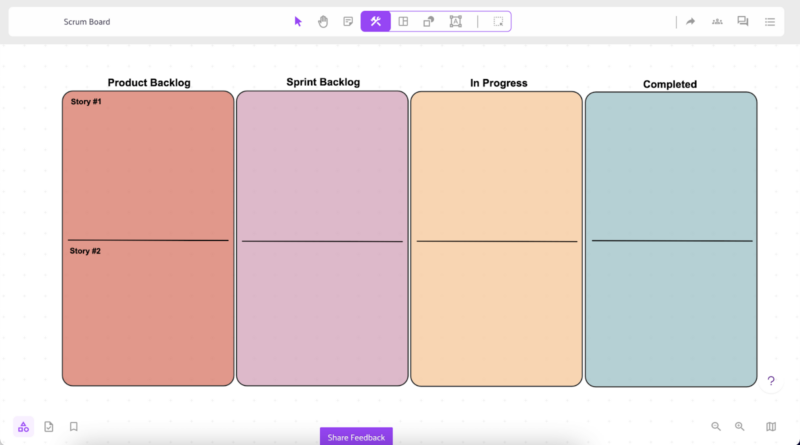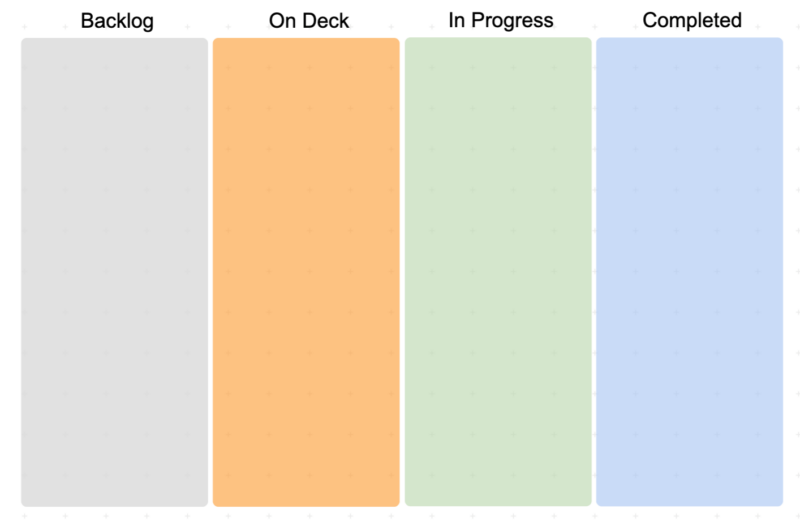Table of Contents
If you’re new to the world of software development and project management, you might have heard the term “Agile” floating around. If you don’t know what this means or why people are using it, it can be incredibly confusing to understand why thinking in an Agile mindset is important.
In this article, we will define the Agile methodology and break down what goes into it and why it’s important.
What is Agile Methodology?
Agile methodology, a transformative workflow ideology primarily applied in software development and project management, stands out for its commitment to cyclical improvements, collaboration, and adaptive problem-solving. Rooted in the principles articulated by the Agile Manifesto founders, it champions:
- Individuals and interactions over processes and tools
- Working software over comprehensive documentation
- Customer collaboration over contract negotiation
- Responding to change by following a plan
These principles guide Agile’s ethos, putting customer needs at the forefront and ensuring the delivery of effective solutions. To distill these principles into actionable guidelines, consider:
- Emphasize the importance of customer contentment by consistently providing valuable software through ongoing delivery processes.
- Embrace flexibility by changing priorities and pivoting without missing deadlines.
- Measure success through working software, emphasizing tangible outcomes.
- Facilitate consistent collaboration and communication within project cycles to stay aligned with your team.
These practical tips elucidate the application of Agile methodology within your workflow, optimizing its potential benefits. Gain a comprehensive understanding of Agile by delving into its structure and building blocks.
Agile Methodology Structure
The Agile methodology is not necessarily a specific way to organize your team but is more about the ideology that you follow when working together. There are other project management strategies that are more effective when building a team structure, but these also fall into the general ideology proposed under Agile.

This overarching philosophy allows you to structure your team in whichever way is most effective to you, enabling you to create a very flexible working environment.
Encouraging flexibility within a team is important because it relates directly to some of the value statements Agile is built on. This is one of the only key team-building principles to follow when using Agile, but under the Agile umbrella, there are a ton of different variations of project management that allow you to further structure your team.
Top 5 Agile Methodology Types
Agile methodologies encompass a variety of approaches and frameworks that share common principles and values. Here are some common Agile methodology types:
- Scrum: Scrum stands out as a highly prevalent framework within the realm of Agile methodologies. It emphasizes iterative development in fixed time periods called “sprints.” Key roles in Scrum include the Product Owner, Scrum Master, and Development Team.
- Kanban: Kanban focuses on visualizing work in progress and optimizing the flow of work. It’s often used for continuous delivery and doesn’t have fixed time frames like Scrum. Teams manage their work based on available capacity and pull tasks from a backlog.
- Extreme Programming (XP): XP is a set of practices that emphasize coding standards, continuous integration, and frequent releases. It’s known for practices like Test-Driven Development (TDD), pair programming, and continuous feedback from customers.
- Lean Software Development: Lean principles aim to minimize waste and maximize value. Lean practices include reducing handoffs, shortening feedback loops, and focusing on delivering what the customer truly values.
- Feature-Driven Development (FDD): FDD is centered around breaking down software development into smaller, more manageable features. It’s a model-driven approach that can be particularly useful for larger projects.
How does Agile relate to other project management strategies?
Some of you might know Agile best by its popular project management strategies like scrum, kanban, or waterfall. These are all distinct ways of delivering products through a cyclical nature of development, but they all have their unique traits. Here is a brief overview of some of the two most popular strategies.
1. Kanban
Kanban is a visualized workflow that helps promote communication and task-oriented delivery within teams. It applies the values of Agile to a task management board that guides the team through their projects.
The board used in the kanban strategy is a kanban board. This board is built around the status of the group’s shared tasks, and walks through the backlog, in progress, and completed tasks. By using this board, anyone on the team can gauge the status of a project at a glance.
This project management methodology is specifically catered towards continual improvements and building projects over time, which are two things that are emphasized through the Agile methodology.

2. Scrum
Scrum takes the fluidity of the Agile methodology and converts it to strict two-week sprints. These sprints and analyzed upon completion and are the baseline for the improvements that come with the next cycle.
The key difference of scrum is its rigid organization. There is a scrum board that the team uses to organize their sprints, and there are multiple roles within the scrum team each has specific jobs.
This project management methodology is built around incremental sprints that increase in speed and efficiency each time. Through this cyclical nature of development, teams are able to improve their speed and workflow.
Deciding between scrum and kanban is always difficult for teams. It ultimately boils down to the context of the scenario you’re working in, and what your team works best with. If strict deadlines and rigid structures are more efficient, scrum might work better. If your team works well with more fluidity, kanban might be the better option. One of the key advantages of Agile is it allows you to work within the framework that works best for you and your team, and that might end up being a blend of these popular strategies.
If you’re interested, in a later article we will highlight the differences between Agile, scrum, kanban, waterfall, and any other popular project management strategies.
Learn more: 14 Agile Methodology Questions You Should Know
Agile Methodology Steps
Agile methodology is an iterative and incremental approach to software development that focuses on flexibility, collaboration, and customer satisfaction. There are several frameworks and methodologies that fall under the Agile umbrella, with Scrum being one of the most popular. Here are the general steps or key principles commonly associated with Agile methodologies, particularly Scrum:
- Product Backlog: The process starts with creating a product backlog, which is a prioritized list of all the features, tasks, and user stories that need to be addressed in the project.
- Sprint Planning: The development team and the product owner collaborate to select a set of items from the product backlog to work on during the next sprint (a time-boxed development cycle, typically 2-4 weeks).
- Sprint Backlog: During the sprint planning meeting, the team creates a sprint backlog, which is a list of tasks or user stories that will be worked on during the sprint. This is a more detailed breakdown of the selected items.
- Daily Standup (Scrum): Each day of the sprint, the team holds a daily standup or daily scrum meeting to discuss progress, and challenges, and plan for the next 24 hours. It’s a short, time-boxed meeting (usually 15 minutes).
- Development: The development team works on the tasks and user stories in the sprint backlog. They collaborate closely and continuously communicate with the product owner and other stakeholders to ensure they are delivering the right features.
- Review: At the conclusion of each sprint, a sprint review meeting is conducted with the purpose of showcasing the accomplished tasks to stakeholders. Feedback is collected.
- Retrospective: Following the sprint review, the team conducts a retrospective meeting to reflect on what went well, what didn’t, and how they can improve their processes in the next sprint.
- Incremental Delivery: The completed work during a sprint is potentially shippable, meaning it can be released if the product owner decides to do so. This allows for continuous delivery of value to the customer.
- Repetition: The process is repeated for multiple sprints, with the product backlog being adjusted and refined based on customer feedback and changing requirements.
- Adaptation: Agile emphasizes the need to adapt to changing circumstances. The team should be willing to change course if necessary and embrace change as a normal part of the process.
It’s important to note that Agile methodologies are not limited to software development and can be applied to various other project management and product development scenarios. The specific steps and ceremonies may vary depending on the Agile framework being used and the unique needs of the project. Scrum, as mentioned earlier, is just one example of an Agile framework, and there are others like Kanban, Lean, and Extreme Programming (XP).
Benefits of Agile Methodology
Agile methodology offers several benefits that make it a popular choice for software development and project management. Some of the key advantages include:
- Flexibility and Adaptability: Agile allows teams to respond to changing requirements and priorities. This is crucial in today’s fast-paced business environment, where market conditions and customer needs can change rapidly.
- Customer-Centric: Agile places the customer in a pivotal role within the development process. Regular feedback and involvement of stakeholders ensure that the final product aligns with their expectations and needs.
- Faster Time to Market: Agile development focuses on delivering smaller, incremental updates or features in short timeframes (sprints). This allows for quicker delivery of functional components and often gets a minimum viable product (MVP) to market faster.
- Improved Quality: The continuous integration and testing in Agile lead to higher product quality. Defects and concerns are detected and resolved in the initial stages of the development process.
- Enhanced Communication: Agile encourages frequent communication within the team and with stakeholders. Daily stand-up meetings, regular demos, and retrospectives help keep everyone informed and aligned.
- Transparency: Agile methodologies promote transparency in project progress and issues. This helps in risk identification and mitigation, as problems are addressed as they arise.
- Reduced Risk: By breaking a project into smaller, manageable pieces, Agile reduces the risk associated with large, monolithic releases. This makes it easier to adapt to unforeseen challenges.
- Higher Customer Satisfaction: Agile allows for ongoing feedback and the ability to change priorities based on customer input. This leads to a product that better meets customer expectations and ultimately results in higher satisfaction.
- Empowered Teams: Agile encourages self-organizing teams that have more autonomy and responsibility. This often leads to higher team morale, creativity, and a stronger sense of ownership.
- Cost Control: Agile can help control costs by addressing issues early and ensuring that resources are used efficiently. It also allows for budget adjustments based on changing priorities.
- Increased Productivity: Agile methodologies promote a focus on delivering value in each sprint, which can lead to increased productivity and a sense of accomplishment among team members.
- Better Risk Management: Agile’s iterative approach allows for the identification of risks and issues early in the project, making it easier to manage and mitigate them.
It’s important to note that while Agile has many advantages, it may not be suitable for all projects or organizations. The success of Agile depends on the commitment of the team, effective communication, and the ability to embrace change. Additionally, some industries or projects with strict regulatory requirements may find it challenging to adopt Agile practices. Therefore, it’s essential to assess whether Agile is the right fit for a particular project or organization before implementing it.
Agile Methodology Advantages
As you can tell, there are a lot of reasons you might be interested in switching your team to an Agile way of thinking. There are some serious advantages to using the Agile methodology, some of which we’ll discuss below.
1. Increases Speed
Increasing speed is one of the biggest benefits of integrating the Agile methodology with your team. Faster cycles of development are helpful for both your team and the customer, meaning everyone is happy. Agile also emphasizes that sprints increase in efficiency over time, meaning you will see long-term improvement in your team.
2. Eliminates Waste
Agile approaches do a good job of cutting out rework by communicating heavily throughout the process. Especially when using a strategy like scrum or kanban, you have a physical board to track everyone’s tasks. These tasks are diagrammed on the board so nobody ends up repeating work and wasting time. This helps improve the overall efficiency of the team and provides value to every single task that is assigned.
3. Builds Team Cohesion
The Agile methodology requires a lot of communication and collaboration between team members, and once you complete a few sprints with your team you will notice people utilizing regular patterns of collaboration. This shows how, over time, working within an Agile mindset can help build cohesion and alignment within your team.
4. Addresses Customer Needs
One of the things that makes Agile so valuable is it increases the satisfaction of the customer. Agile gives the customer something on a regular basis and is built to accommodate their changing needs and circumstances. When your team can cope with these changes and continually deliver what they’re asking for, the customer will be extremely satisfied with their results.
Learn more: Waterfall vs Kanban vs Scrum vs Lean
Agile Methodology Applications
The principal application of the Agile methodology and its related strategies is within software development. While this remains to be the case, not every strategy within the Agile methodology was developed with software development in mind. For example, kanban was created in the 1950s to improve Toyota’s manufacturing flow. Since then, however, the Agile methodology and its related strategies have mainly focused on building software and structuring development teams.
Other than software development, the Agile methodology can be applied throughout an organization to affect the way people see and accomplish projects. Agile is a way of thinking and being able to establish solid patterns based on these simple principles can have effects throughout your business.
For example, one of the biggest principles in Agile methodology is the ability to make changes based on cycles of development. Having a mindset of continuous improvement can be applied to your sales deck, the way you communicate with your team or the structure of your regular deliverables.
Looking at these items through the lens of consistent and continual improvement means you can easily analyze their efficiency and make improvements where necessary. This can apply anywhere outside of software development and is a great way for teams to improve their processes and products.
Conclusion
Whether you’re developing software or you’re working in project management, adopting the Agile methodology for your team can help increase efficiency in many ways. Hopefully, this article has helped outline what the Agile methodology is and why it’s so important, and if you want to learn more about how to implement these strategies online, make sure you check out Ideascale Whiteboard.
Most Recent Posts
Explore the latest innovation insights and trends with our recent blog posts.













